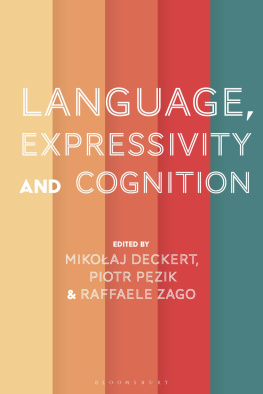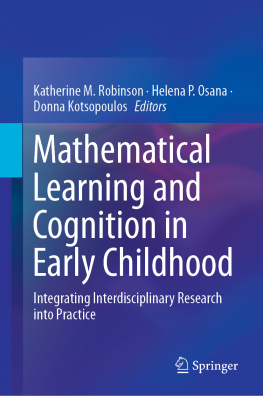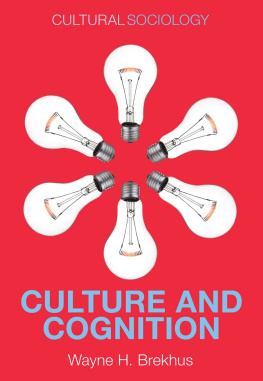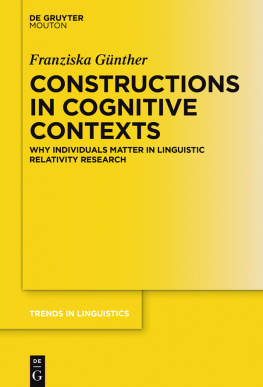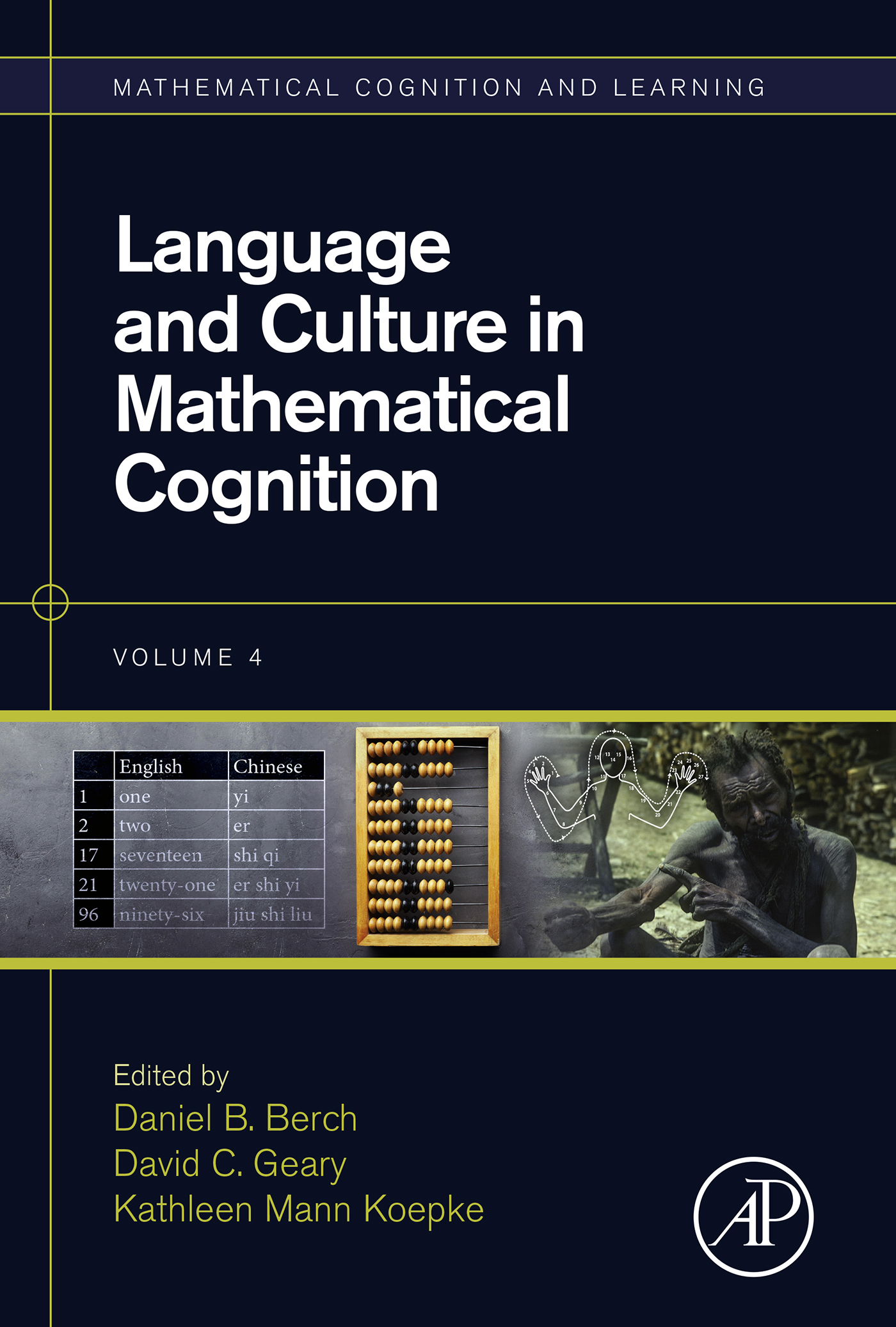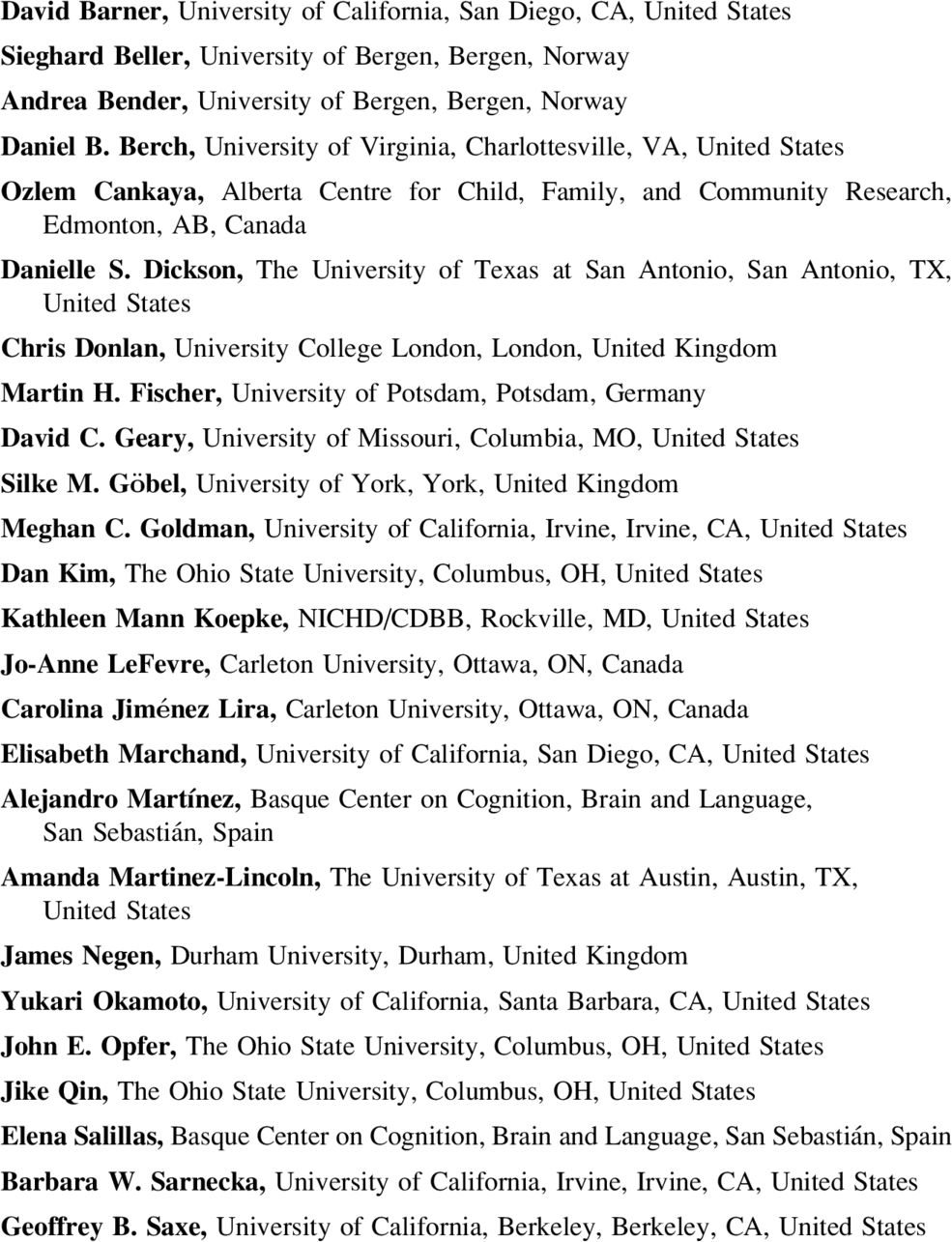Language and Culture in Mathematical Cognition
first edition
Daniel B. Berch
Curry School of Education, University of Virginia, Charlottesville, VA, United States
David C. Geary
Psychological Sciences, University of Missouri, Columbia, MO, United States
Kathleen Mann Koepke
Eunice Kennedy Shriver National Institute of Child, Health and Human Development (NICHD), National Institutes of Health (NIH), Bethesda, MD, United States

Copyright
Contributors
Foreword: Mathematical Cognition, Language, and Culture: Understanding the Links
John Towse, Lancaster University, Lancaster, United Kingdom
Psychologists have long had a fascination with the twin notions of homogeneity and heterogeneity. Homogeneity has a technical and statistical meaning that describes the uniformity or similarity of a sample or population. For example, if all children arrived at exactly the same answer to a mathematical problem and did so through exactly the same computations, there would be homogeneity of process and output. If all the children received entirely the same teaching about such problems (no less, no more), that would also give rise to homogeneity, on the input side. The flip side to this is heterogeneity , where there is nonuniformity and variation. For example, if different children use different strategies or the same children use different strategies for solving different problems, even for something as apparently simple as addition (), we have heterogeneity on the input side.
Psychologists have navigated a troubled relationship with these twin terms. The purported methodological advantages of each can quickly crumble and present themselves as limiters or hurdles in addressing important questions of validitythe extent to which research findings accurately describe the state of the world, its processes, and relationships. What we have needed is the right perspective on how both homogeneity and heterogeneity, in the present case for mathematics across cultural and linguistic contexts, can best be harnessed and exploited. The current volume takes a confident, authoritative, and highly skilled approach to addressing the consequences of homogeneity and heterogeneity in order to better understand mathematical cognition.
Sampling uniformity or homogeneity can be crucial in order to improve the signal-to-noise ratio in the detection of an important psychological effect, both for within-participant and between-participant designs. Yet a long-standing concern has been the potential distortion that this uniformity produces on real effects in the world. For example, a sample comprising university students at a Western campus might be asked to carry out single-digit multiplication problems. Phenomena such as the problem-size effect (questions with larger numbers take longer to solve and are more error-prone) and 5-operand advantage (multiplication combinations with operands of 5 (e.g., 5 4) are solved faster than comparable combinations that don't include a 5 (e.g., 7 3)) appear robust and consistent and have been documented repeatedly. Yet, it turns out that findings might be biased due to participant homogeneitywhen performances of Canadian and Chinese students are examined separately, some important differences emerge (). However, only when we understand the relevant variableshere, the educational experience of the participantscan such differences be teased apart. The same limitation may be true for a sample of children who, for example, attend a school that is conveniently close and accessible to a university campus of a key researcher on a project; there may be biases introduced by unwittingly drawing on, for example, children from highly educated and prosperous families.
The implications of such issues are well recognized, at least in principle, even though we cannot always know in advance which variables are going to be important. However, more subtle effects may be occurring that are harder to recognize due to the broader forces and shifts that can occur over time. In terms of the number of school leavers who go on to study university degrees, the university student cohort in the United Kingdom is now more diverse than it was, say, 40 years ago. The representativeness of a student sample in the United Kingdom today (relative to the population of mostly young adults) is different from the representativeness of the sample in a previous generation. The higher educational sector is also much more international than it was 40 years ago, for a host of economic and financial reasons. This again can affect the demographic student profile that is sampled.
Demographic changes on a university campus, for example, can be seen, audited, and tracked, especially where they may involve explicit institutional plans. But less obvious changes may take place in schools also. School children may become more or less homogeneous following changes over time in local migration, family size, and economic status. So even when we understand the principle of how biases can arise, recognizing the potential relevance of changes in a sample can be extremely difficultall the more so if we become anchored to out-of-date representations of the sample profiles.
Sufficient heterogeneity is of course a prerequisite for studies of individual differences (). Without a spread of scores on the variables of interest, there is inevitable attenuation in the potential for tracking mediating processes and associations that might actually be relevant in a population. One of the problems though is that, a priori , it might not be feasible to identify all the dimensions that are pertinent. Without the empirical and conceptual grounding to understand the associations that matter, heterogeneity can lead to true effects being masked.
In summary, research design can be a tricky business. It takes critical thinking and careful interpretation to put together the right mixture of homogeneity and heterogeneity so as to yield coherent and useful findings. And herein lies the essential beauty of this volumethe demonstration of how science can benefit from the ties that bind and the dissociations that distinguish mathematical cognition, language, and culture.
Mathematics is an abstract code, and mathematical concepts and relationships are lawful, predictable, and often cumulative. In other words, the mathematical domain contains strong regularities. Yet even so, we know that the configurations through which children experience mathematical information can vary substantially. The ways in which children are taught can vary across generations (such that parents, used to representing multidigit subtractions in a vertical format, view with bemusement how their children have been taught to tackle the same problems by displaying them in a horizontal format). This is exemplified in a fascinating review by Opfer , Kim , & Qin of the link between mathematics performance, cognitive abilities, and curriculum specifications. They point out that the oft-cited learning gap between U.S. educated and Asian educated children may be a recent historical phenomenon. Okamoto also makes a profound point about the potential impact of cultural and linguistic differences on a smaller timescale. The potential for language-coding characteristics to shape learning and understanding of number names and early number processing is not necessarily the same as the potential impact of these exact same differences on other, later mathematical processes. Of course, there might be cascading effects of competence and confidence, as relative mastery with one mathematical process transforms into challenges to be faced in acquiring the next, different process. Nonetheless, the point at which these exogenous influences and sources of heterogeneity impact children's learning process is crucial. So for Okamoto , the path of core numerical knowledge need not run in parallel with the path of specific skills.


